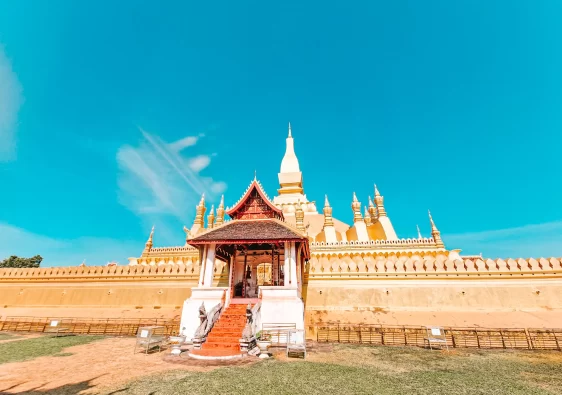Planning a 10 day Central Vietnam Itinerary sounds exciting—until you’re knee-deep in Google searches, overwhelmed by options, distances, and whether you should head to Hue before or after Hoi An. I’ve been there, and I get it. Crafting the perfect route through Hoi An, Da Nang, and Hue—each packed with history, culture, and coastal charm—can feel like trying to solve a travel puzzle.. After spending four months in Vietnam across 2024 and 2025, I’ve fine-tuned what I believe is the ideal itinerary for cultural travellers who crave more than just beach time. If you’re looking for a trip that blends ancient towns, golden coastlines, royal relics, and authentic experiences, you’re in the right place.
Just so you know, this post contains affiliate links. If you book a tour, hotel, or buy something through one of these links, I may earn a small commission—at no extra cost to you. It helps me keep this blog running and full of travel tips. Thanks for the support!
Why Visit Central Vietnam on a 10 day Itinerary?
Hoi An, Hue and Da Nang are the three most famous cities in central Vietnam for tourists, and should form an essential part of your cenrtal Vietnam itinerary.
- Hoi An is possibly my favourite city in Asia, a gorgeous blend of history, faded grandeur, shopping and blooms. It’s also the best place in Asia to get tailored clothes. Tailor shops suit every budget, from high-end boutiques to backpacker-friendly options.
- Hue is the key to Vietnam’s Imperial Past, with gorgeous palaces and ornate tombs telling the story of the Vietnamese Emperors and French colonisation.
- Da Nang is an emerging tourist hotspot, a city with a few famous landmarks like the Lady Buddha and Dragon Bridge, but a much more to do including fascinating workshops, yoga and markets alongside its famous beach.
And linking them all is the stunning Hai Van Pass. One of my central Vietnam highlights was riding pillion on an Easyrider motorbike, the wind in my hair as the coastline unfurled like something out of a dream. That moment—between Da Nang and Hue—was when I felt like I was really in Vietnam.
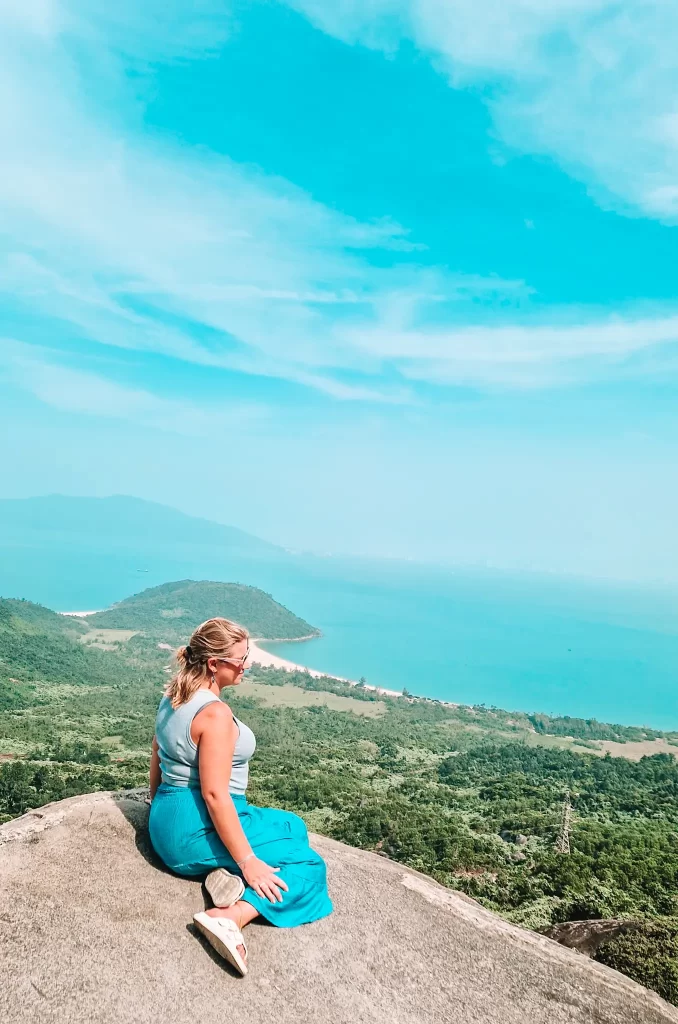
In this post, I’ll share a clear, thoughtful 10 day central Vietnam itinerary that lets you soak up the UNESCO-listed lantern charm of Hoi An, the vibrant beaches and cafes of Da Nang, and the imperial grandeur of Hue—without backtracking, rushing, or missing the good stuff. Let’s make your Central Vietnam adventure feel effortless and unforgettable.
Your 10 Day Central Vietnam Itinerary
This 10 day Central Vietnam Itinerary takes you from Da Nang north to Hue, but it could easily be done in reverse. While both cities have strong transport infrastructure, including airports and train stations, you’ll likely find it easier to get an international flight into Da Nang. You can then continue on your Vietnamese journey on a domestic flight from Hue, or take the train to Hanoi or Ninh Binh.
Day 1: Start Your 10 Day Central Vietnam Itinerary in Da Nang
Hotel: Da Nang
Depending on your arrival time, you might not have much time to do anything on Day 1. Check into your hotel and explore the city around you if you arrive early enough, or just rest after a long journey.
Day 2: Enjoy Da Nang’s beautiful My Khe Beach
Hotel: Da Nang
Wake up ready to try your first central Vietnam delight: Salt Coffee. Invented in Hue in 2012, it’s become a staple of Vietnamese coffee culture, and it is delicious! Head to Golo, one of my favourite cafes in Da Nang, for their delicious salt coffee.
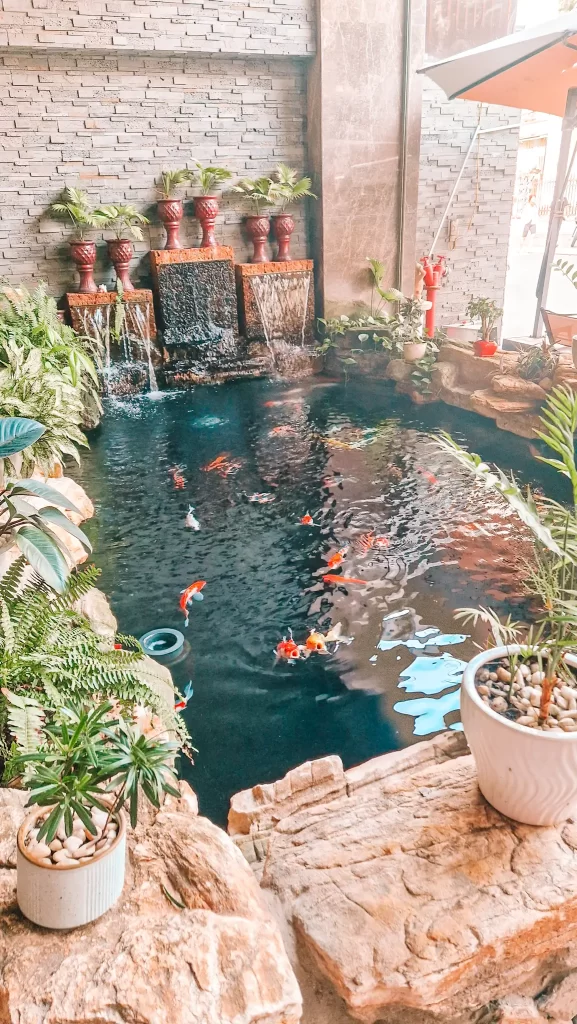
Once you’ve had enough caffeine, spend your day relaxing on Da Nang’s My Khe beach, one of the longest in Asia. If you pick a spot near An Thuong, the main tourist area, you’ll find busy sunbeds, a bustling beach bar and see the life of Da Nang passing you by. Head a bit further away from the main tourist area to find quieter sunbeds and fewer swimmers in the ocean! If you’re feeling active, you can rent surf boards and body boards on the beach, or try parasailing.
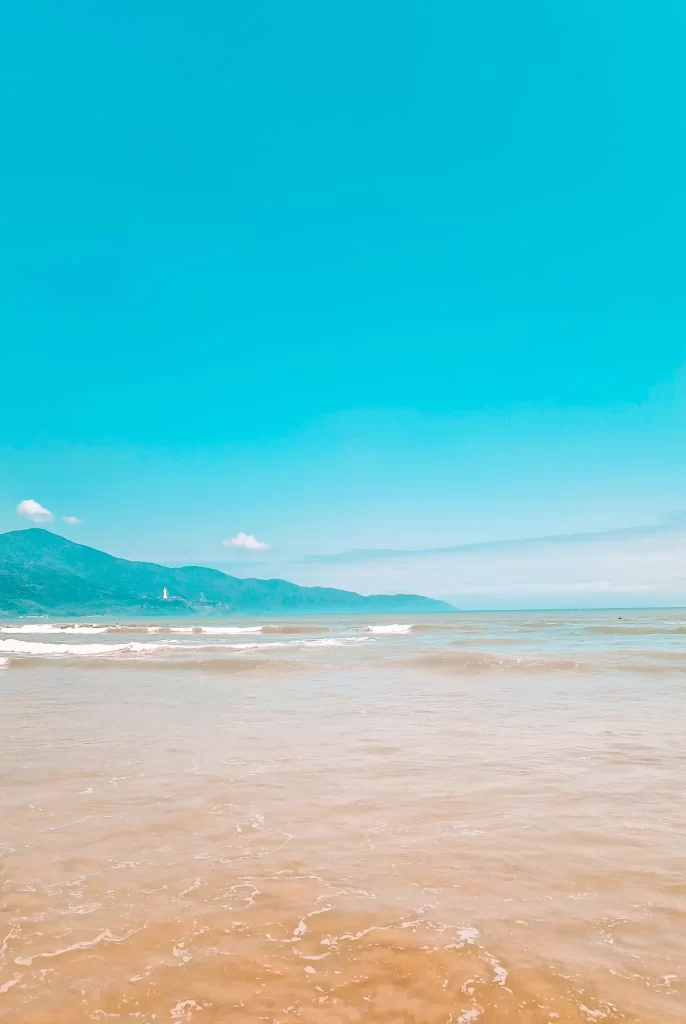
Later, explore Da Nang’s many incredible restaurants, and try one of my favourite vegetarian restaurants in the city, or head to the Son Tra Night Market at the end of the Dragon Bridge. If you’re in Da Nang on a Friday or Saturday, you can also enjoy the fire show at the Dragon Bridge at 9pm.
Day 3: Explore all the unique things to do in Da Nang
Hotel: Hoi An
While Da Nang isn’t as famous as Hoi An or Hue, it’s a growing tourism city. Take a day to explore everything this vibrant city has to offer, starting your morning with the beautiful and serene Lady Buddha, who floats her protection over the city. Built in the noughties, Da Nang hasn’t experienced severe typhoon-damage since, and locals attribute this to her presence.

Next, head to the Greek-inspired Son Tra Marina for coffee and Instagram-perfect pictures. While this cafe is touristy, it’s still incredible to see such a slice of Greek perfection in the middle of Vietnam.

During the afternoon, enjoy some of the unique experiences Da Nang has to offer. Consider visiting Han Market, where you can pick up some trainers, handbags or clothes for an excellent price. If you’re looking for a bargain, this is the place to go: I was quoted 800K VND for a handbag in Hoi An that would have cost me less than 250K VND at Han Market.

You could also take one of the many workshops on offer in Da Nang – I recommend the jewellery workshop at Ngay Mai, but there are plenty of others to choose from.

After you’ve enjoyed your day in Da Nang, transfer to Hoi An, which is about 40 minutes away. You can take a Grab, or one of the regular minivans between the cities, which you can book on 12goasia.
Day 4: Hoi An – Explore This Beautiful City
Hotel: Hoi An
Cost:
- 120K VND for ticket to Hoi An Ancient Town
- 150k VND for a Lantern Boat for 1-3 people / 200k VND for 4-5 people.
- $1 for a lantern to release on the river
For your first day in Hoi An, the best place to start is by just wandering around the Ancient Town. Hoi An’s streets are incredibly beautiful, and you’ll love the time spent walking through the streets and marvelling at the architecture.
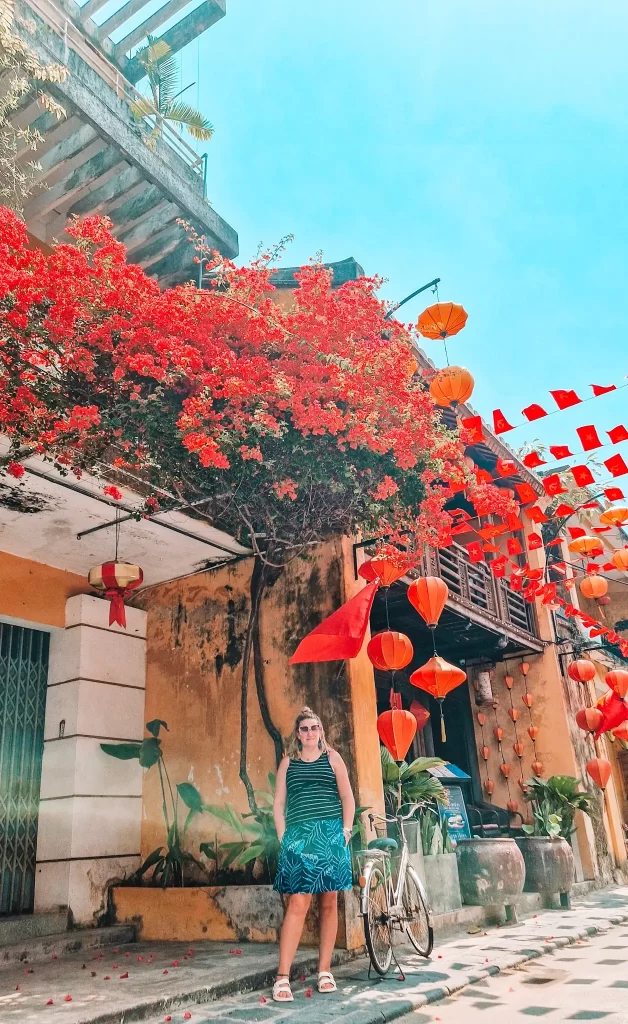
Buy your ticket to the Ancient Town, which gains you access to key sites across the city. The ticket includes access to several categories of sites, with entry permitted to a few in each—though the system can be confusing to navigate.
Make sure to cross the beautiful Japanese Bridge, and pose on the waterfront just before it to get some amazing pictures. Check out the different temples dotted around town, and visit one of Hoi An’s ancient houses.
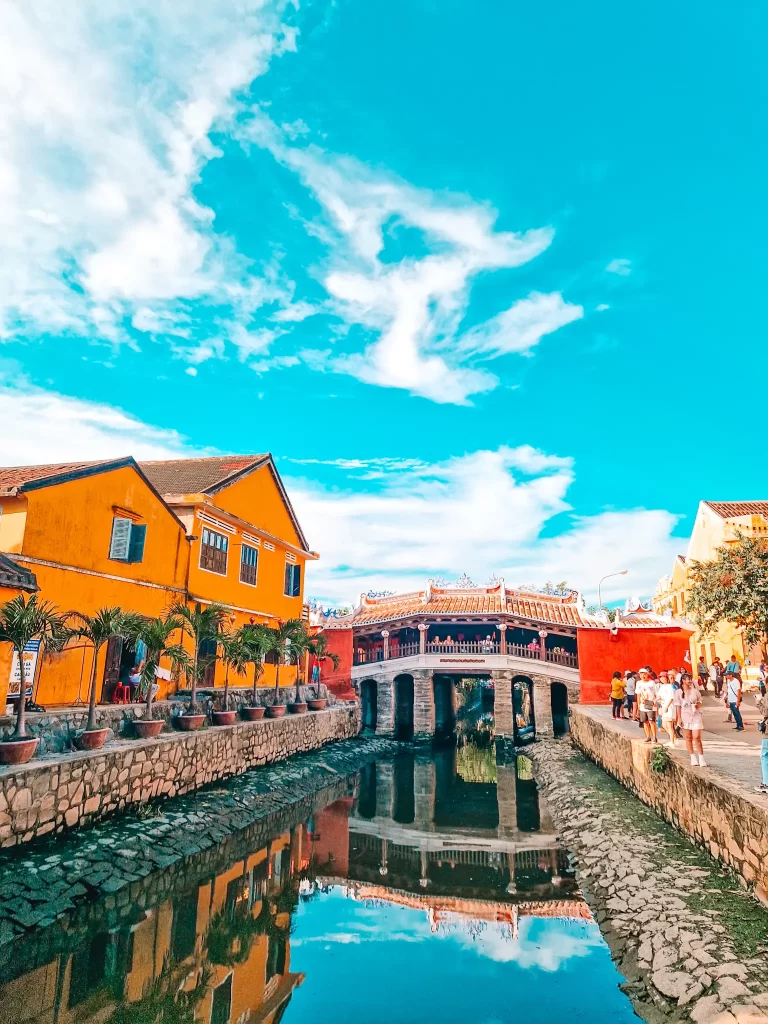
If you plan to get anything tailored in Hoi An, make sure to do your research, visits and measuring today. It takes at least 24 hours for tailors to make your outfit, and you might then need further amendments.
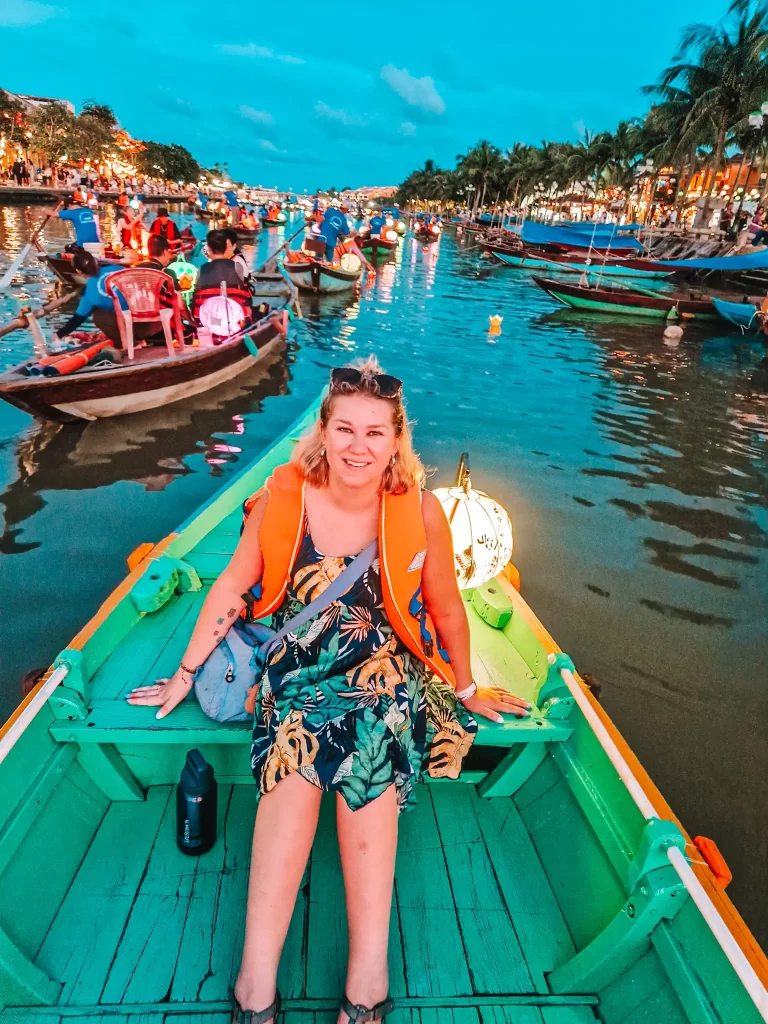
Spend the evening in the Old Town, and take a lantern boat at sunset. This Hoi An tradition is busy, but incredibly beautiful. Choose one of the official boats to make sure you don’t get scammed – find out all the details in my full Hoi An guide.
Day 5: Take a day trip out of the cities
Hotel: Hoi An
While Hoi An is really beautiful, there are also a number of incredible day trips in and around the city. For your fourth day, consider taking a day trip to either the Marble Mountains or the My Son archaeological site.
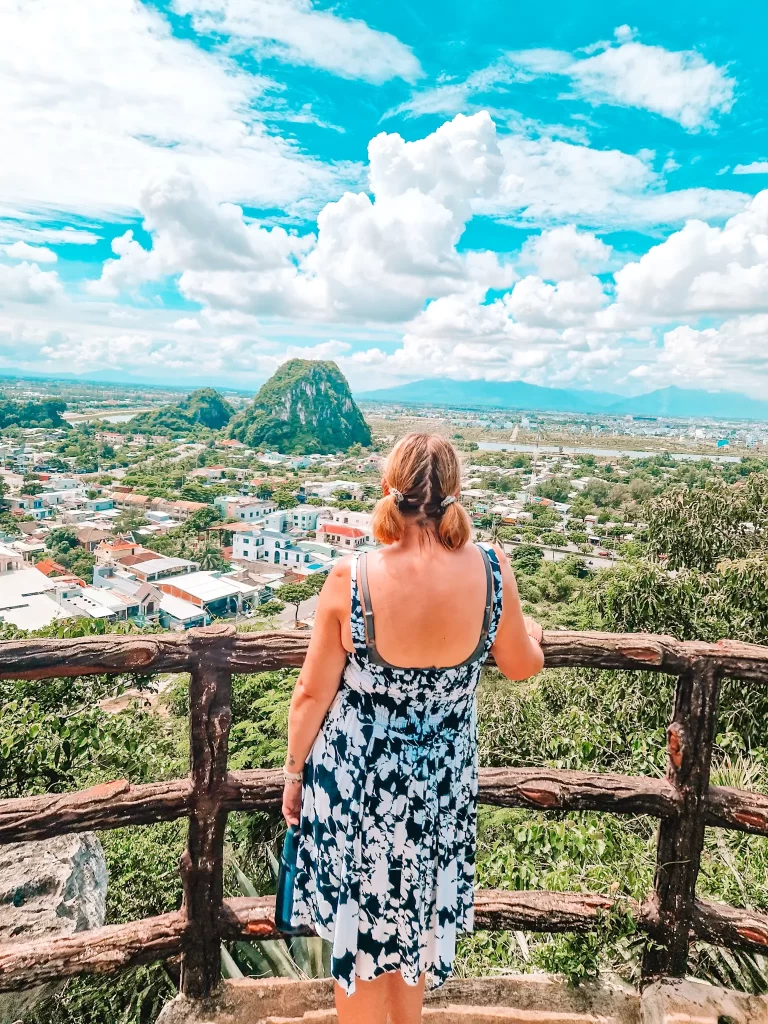
The Marble Mountains are huge limestone karsts looming over the countryside between Da Nang and Hoi An. If you choose this day trip, you’ll visit the Water Mountain, which has caves depicting Hell and a beautiful Heaven area at the top of the mountain, which offers glorious views. You’ll also get to visit a marble workshop and see incredible craftsmanship as artisans sculpt form the beautiful statues the area is famous for.

The My Son archaeological ruins date from the Champa Kingdom, which pre-dated modern Vietnam. They’re a UNESCO Heritage Site, and a visit gives you the chance to explore Vietnam’s more ancient history, as well as see the damage the site suffered during the Vietnam War.
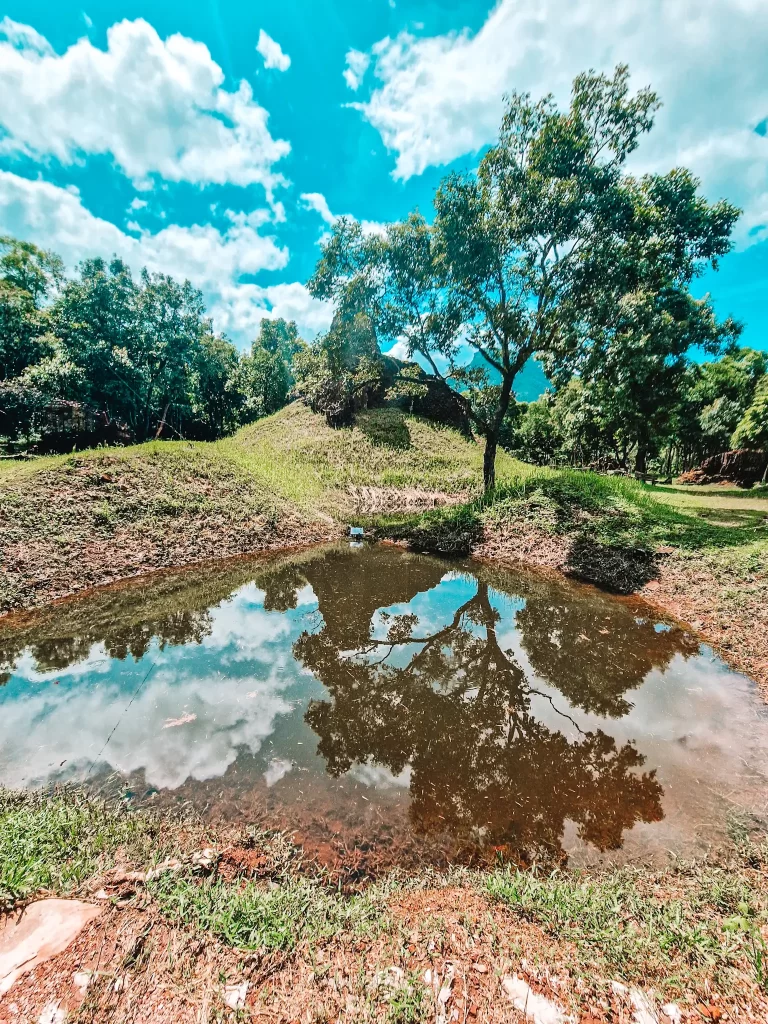
I’ve done both these day trips from Hoi An, and I think they’re both really interesting. Find out more details to help you make your choice in my full guide to day trips from Da Nang and Hoi An.
Day 6: Hoi An – Coconut Boats, Shopping and Exploring
Hotel: Hoi An, or if you’re willing to move for twos nights, consider a hotel in Hoi An’s rice fields.
Start your day with a trip on one of Hoi An’s famous coconut boats, which will take you down the river and into quiet mangrove-lined waterways. I barely saw any other people, and spent a peaceful few minutes learning how to fish for crabs.

Head back into town to the Reaching Out Teahouse to try a tea or coffee flight. This beautiful space was created to provide job opportunities for deaf locals, and it’s a haven of peace where talking loudly is discouraged.
One of your days in Hoi An should include a spa treatment, and I recommend getting a shampoo. This treatment is the self-care you didn’t know you needed!
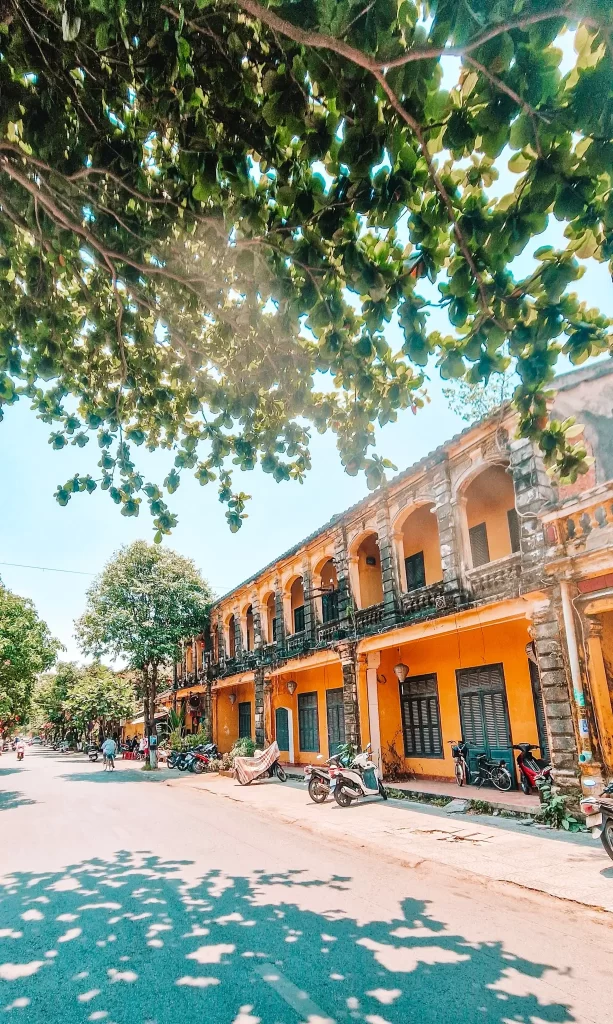
If you had anything tailored, build time into your schedule today for your fittings – you might need to go back multiple times for amendments.
Finally, visit Hoi An’s lively nightmarket, just across the bridge on An Hoi. If you’re feeling lively, this part of the city is full of riverside bars, including the famous Mr Bean bar!
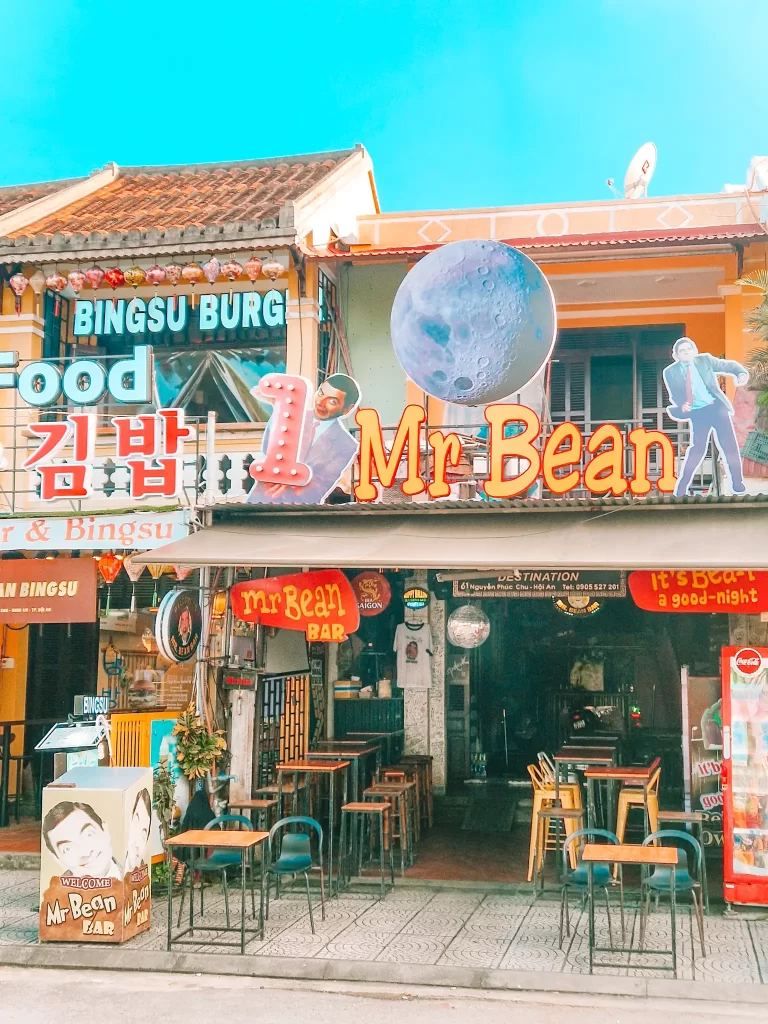
Day 7: Visit rural Hoi An’s gorgeous rice fields, and spend the afternoon on An Bang beach
Hotel: Hoi An, or if you’re willing to move for two nights, consider a hotel in Hoi An’s rice fields.
Cost: 650K VND + for a bike trip around the rice fields
Rural Hoi An is stunningly beautiful. Use Day 7 to get out of the city into the lush green rice fields around the city. You could take a guided tour, which will usually take you on bikes through the rice fields, possibly via a buffalo ride, before you join a cooking class at a family restaurant.
You can also explore independently via bike, taking in some of the beautiful and relaxing cafes that overlook the rice fields.
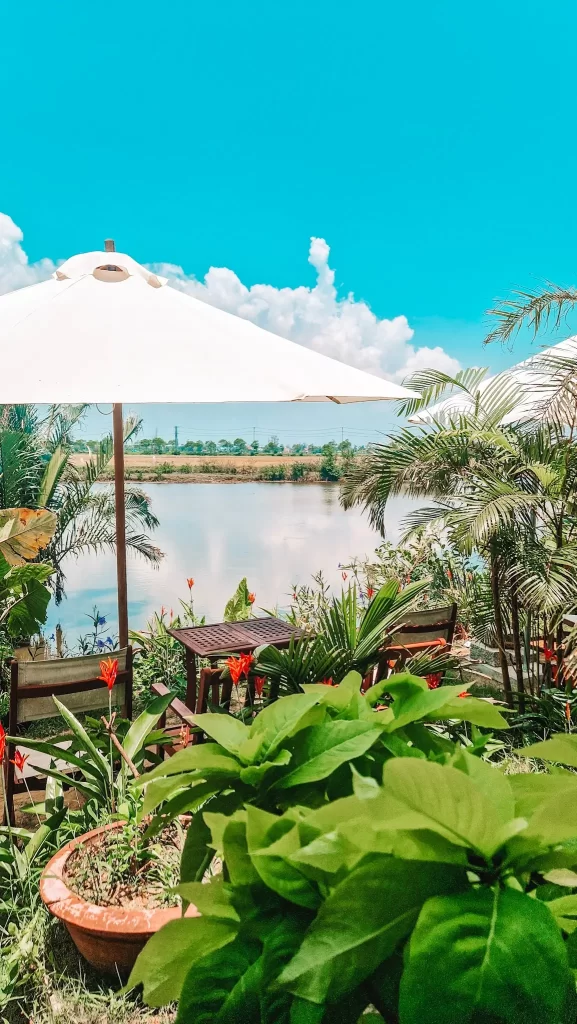
In the afternoon, take a Grab across to An Bang, the nearest beach to Hoi An. Quieter than Da Nang’s My Khe beach, An Bang offers a number of lovely restaurants along the seafront that also have their own sunbeds for rent. Spend a day listening to the sound of the waves, before heading to Ken’s Vegetarian, my favourite restaurant in An Bang, for dinner.

Day 8: The stunning Hai Van Pass
Hotel: Hue
Cost: $42 for a 1-way Easyrider Tour of the Hai Van Pass
It’s time to leave Hoi An and head north, and the best way to do this is via the Hai Van Pass. This beautiful road connects Hoi An, Da Nang and Hue, and is one of the most scenic routes in Vietnam. It takes you along the coast and then up into the mountains to the highest point between the cities, a site of historical strategic importance.

Along the way, you’ll visit cafes with incredible views, a small waterfall where you can swim, and have lunch at the beautiful Lang Co Beach.
The best way to do this is via motorbike – either independently or via Easyrider (where you ride as a passenger behind a professional driver). I wrote a full guide to my Hai Van Pass Easyrider experience, and I really recommend this option as it gives you time to take in the glorious scenery around you.

Once you arrive in Hue, the Easyrider company will drop you at your hotel. Take the evening to get settled and explore Hue’s Walking Street.
Day 9: Understand Vietnam’s Imperial Past in Hue
Hotel: Hue
Cost:
- c.£10 for a guided day trip via Get Your Guide
- 450K VND for tickets to the Imperial City
- 50K to enter the Ancient Garden House (if you do the guided tour)
Hue was once the capital of Vietnam under its Emperors, and they built stunning palaces to reflect their power. Take a day to visit the beautiful Imperial Palace and the Imperial Citadel. You can also visit some of the tombs of the Emperors, which they built during their lifetimes and which were often seen as a sign of enormous excess.

I recommend doing this as a day trip, because you’ll get the most out of the historic sites with a guide. Since there’s so much to see in Hue, a guide can help you avoid spending too much time traveling between sites. Most tours will also include the beautiful Pagoda of the Celestial Lady, and a boat ride down the Perfume River on a dragon boat. My full guide to Hue gives a full itinerary for the day, including other stops along the way.
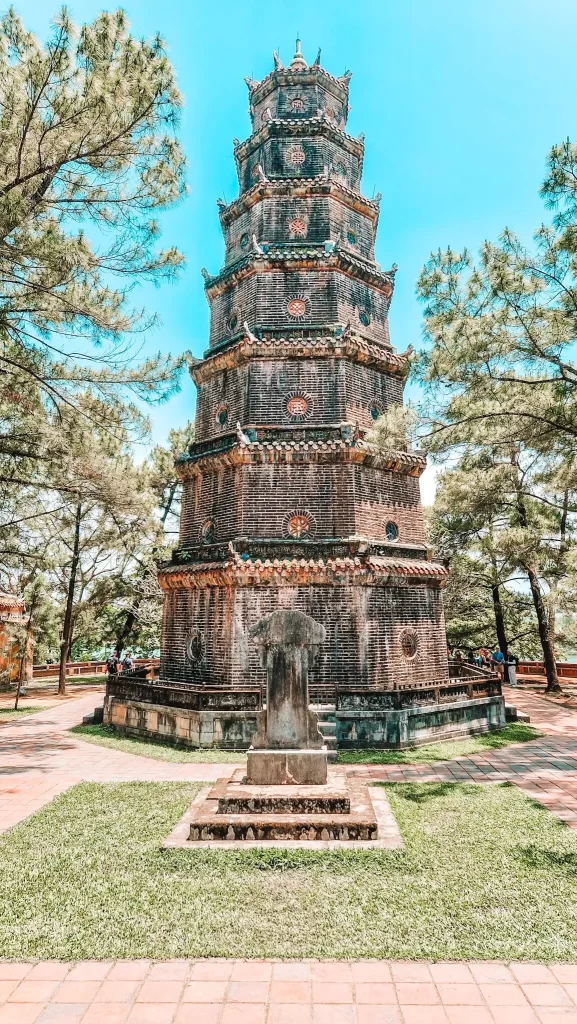
In the evening, head to Tinh Tam Vegan, where you can try some of Hue’s unique cuisine with a vegan twist. I loved their Nam Rice Cake, a steamed rice cake traditionally made with rice and fish sauce, as well as their spring rolls.
Day 10: End your 10 Day Central Vietnam Itineary at Hue’s creepy Abandoned Waterpark
Hotel: wherever your next stop is!
Cost: 20K to enter the Abandoned Waterpark
Your final day will take in one of the most unique things on your central Vietnam itinerary: the graffiti-covered ruins of Hue’s Abandoned Waterpark. Created in the early noughties and abandoned shortly after, the waterpark has become a bit of a tourist destination as a safe place to do urbex-ing.

You’ll walk around the beautiful lake to the huge dragon statue that looms over the water, before moving on to find abandoned slides, swimming pools and even an old noughties simulator. The area is now run by locals, and the path around the lake has been paved, making it accessible for almost everyone. Find out everything you need to know in my full Hue itinerary.
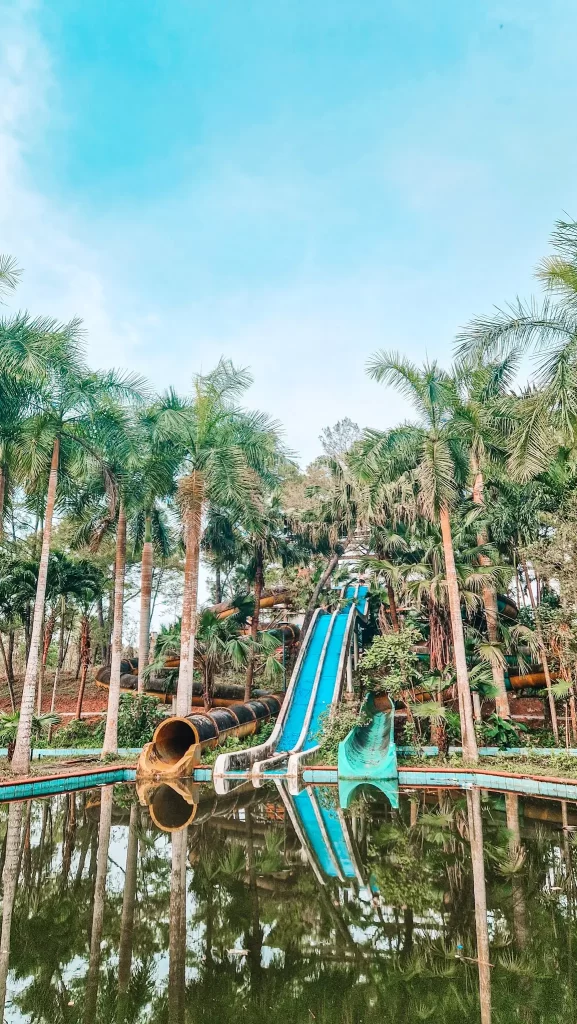
The Abandoned Waterpark is a memorable and unusual end to your Central Vietnam adventure. Head back to Hue for your onward journey, whether that’s by plane, one of Vietnam’s famous sleeper VIP buses, or on the overnight train up to Hanoi.
What to do if you have extra time?
If you have extra time to spend as part of your central Vietnam itinerary, consider building in a rest day at An Bang beach in Hoi An, or simply lazing by the pool and cafe hopping in Hoi An itself. This will give you the best chance of not feeling too exhausted to enjoy the rest of your journey.

If you’re keen to be active, there are lots of other optional activities that you could do in this part of Vietnam that you could incorporate at different points in your itinerary. For example, if you love theme parks, you could set aside a day to head to Bana Hills, near Da Nang. You could also plan to go snorkelling around the Cham Islands, just off the coast near Hoi An. You could easily add an extra day to your time in Hoi An, and chill out in the town or spend more time exploring the rice fields.
Frequently Asked Questions
Where are Hoi An, Da Nang and Hue?
Hoi An and Da Nang are two cities in central Vietnam. They’re about 45 minutes – 1 hour apart, with transport easily available between the two. Da Nang has a major international airport, meaning that many people will arrive into central Vietnam via Da Nang, especially on internal flights from Ho Chi Minh City or Hanoi.
Hue is about 2.5 hours from Da Nang by bus, or about 3.5 hours by train. It’s also in central Vietnam, and has its own airport, although this is smaller than Da Nang.
If you’re keen to know more about Vietnam and its recent history, check out the books written by Vietnamese authors in my guide to powerful books about Southeast Asia.
Is Vietnam a good destination for solo female travelers?
Absolutely. Both Da Nang and Hoi An are considered safe and welcoming for solo travelers, including women. Use the same precautions you would at home—avoid poorly lit areas late at night and use Grab (the Asian version of Uber) instead of unlicensed taxis.
Both Da Nang and Hoi An offer numerous Facebook groups for travellers who are staying a bit longer – including ones specifically for women. These are a great source of ad-hoc events in the area, such as the sound bath I enjoyed in Da Nang.
Are Hue, Hoi An and Da Nang Safe?
Many travelers wonder about safety in Vietnam. The good news is that Da Nang and Hoi An are considered two of the safest cities in Vietnam for travelers. The An Thuong area of Da Nang in particular is very friendly and welcoming. Hoi An is a very touristy town, and busy into the evening, so there are almost always people around. However, take the usual precautions, particularly if you are out late at night. For example, make sure to use Grab (the Asian version of Uber) rather than unlicensed taxis or motorbikes.
The British Foreign, Commonwealth and Development Office (FCDO) states that the most frequent types of crime in Vietnam are bag snatching and theft. However, rates of crime in Da Nang are very low and Hoi An is considered one of the safest cities in the world for solo travellers. Numbeo reports very low levels of crime in Hue, and I felt very safe while I was there. People often leave bags – and even laptops – at tables in cafes. That said, it’s still wise to take standard precautions, especially late at night.
When is the best time to visit central Vietnam?
The best time to visit central Vietnam is the peak tourist season, from April to August. This offers drier weather and sunnier days, although temperatures do get very high later in this season, reaching 40C in July and August.
September to March is considered the wet season, and is less popular with tourists.
I was in Da Nang in late February and March in 2025, and the weather was very variable. Some days had beautiful sunshine, while others had drizzling rain. By April, summer had arrived and it was very hot.
How to get to Da Nang and Hoi An: Air
Da Nang International Airport is about 15 minutes from Da Nang and less than an hour from Hoi An. It’s a modern airport with excellent facilities. Regular flights arrive from domestic destinations including Hanoi and Ho Chi Minh City, as well as international destinations like Bangkok, Kuala Lumpur, Singapore and Siem Reap.
The best way to get from the airport to Da Nang is via Grab. This is quick and cheap, and should cost about 100K VND-130K VND depending on the time of day and demand. To get to Hoi An, you can also take Grab for about 300K VND. You can also ask your hotel to organise a private transfer, or I was able to get a free transfer to my Da Nang hotel via a Booking.com special offer with my hotel booking.
While there are public buses, these tend to focus on main part of the city, and don’t usually reach the An Thuong area where most hotels are located. There are also shared shuttle buses, which you can book via 12goAsia – I used these to get from Da Nang to An Bang and it was quick and easy.
How to get to Da Nang and Hoi An: Train
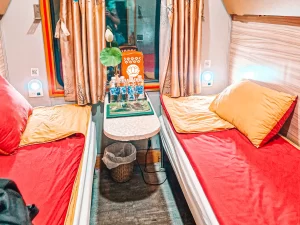
Da Nang is one of the main stations on Vietnam’s extensive railway network, which stretches from Ho Chi Minh City in the south to Hanoi and even Sapa in the north. Trains arrive and depart from Da Nang Train station, with departures to key destinations several times a day. The train station is about 15 minutes drive from central Da Nang, and about 1 hour from Hoi An.
Train journeys from Da Nang, aside from Hue, tend to be long:
Hanoi – 17 hours
Ho Chi Minh – 19 hours
Hue – 3.5 hours
I wrote a full guide on the Vietnamese trains I took from Hoi An (via the train station in Da Nang) to Ninh Binh, and then from Hanoi to Sapa, I loved the experience!
How to get to Da Nang and Hoi An: Bus
Vietnam’s buses have gained internet fame in recent years, with the VIP Sleeper buses offering some of the best luxury bus travel in the world. Taking a bus from Da Nang or Hoi An to other destinations across Vietnam is a popular option, with destinations including Ninh Binh, Hanoi, Ho Chi Minh City, Hue, Nha Trang and others.
Buses arriving and departing Da Nang will usually operate from bus company offices across the city, rather than a central bus station. The best way to get from these to your destination is usually Grab. Buses in Hoi An have a range of departure points across the city, as big buses can’t enter the Old Town area. You’ll need to work out the best departure point for you, or some will offer a free pickup service via minivan.
Buses in Vietnam vary in terms of comfort and price, for example VIP sleeper Buses offer wide beds with a seat on either side of the aisle, while cheaper sleeper buses have much less space as they have three beds per row. Do your research in advance to figure out which option suits you best. I read reviews on 12goasia and on Google before selecting a company.
How to get to Hue: Air
If you choose to do this itinerary in reverse, you’ll need to start in Hue.
Hue’s Phu Bai International Airport is located just south of the city, about 30 minutes drive from the city centre. While I haven’t visited the airport to confirm, it’s likely that Grab is easily available from the airport to the city, as well as regular taxis. However, there are some reports that Grab is prohibited from picking people up at the airport itself, so you might have to walk a bit to find your Grab driver. It’s unclear whether these reports are fully up to date, as my Grab App shows that I can request a car from the Arrivals area.
My Grab app shows a current cost of around 250K VND for a trip from the airport to central Hue.
How to get to Hue: Train
Hue is on the main Reunification Express trainline from Hanoi to Ho Chi Minh City. You can get the train from Hanoi to Hue easily (about 14 hours) or from Ninh Binh. Find schedules here.
I booked via 12goasia, who then purchase tickets on your behalf – note that this means there won’t be instant confirmation, and tickets aren’t guaranteed.
If you’re planning a longer train journey in Vietnam, I really recommend it! Check out my full guide to Vietnam’s sleeper trains before you plan your trip.
How to get to Hue: Bus
Like much of Vietnam, Hue is well linked by an extensive bus network. Buses run to Hue from destinations such as Hanoi (about 13 hours), Ninh Binh (about 12 hours), Nha Trang (12-15 hours), Sapa (17-19 hours) and even Ho Chi Minh City (about 20-24 hours).
There are frequent rumours about lack of safety on Vietnam’s buses, with drivers speeding on roads. I would personally avoid picking the bus with the shortest journey time on a long-distance bus, as this is likely to lead to added pressure on the driver to go fast.
Is it easy to get around central Vietnam without speaking Vietnamese?
Yes, in most tourist areas, basic English is widely spoken, especially by hotel staff, tour guides, and Grab drivers. That said, learning a few phrases like “Xin chào” (hello) or “Cảm ơn” (thank you) is appreciated and can enhance your experience.
Make sure you have Google Translate downloaded onto your phone for any more complex situations.
What should I pack for Central Vietnam?
Bring light, breathable clothing for hot weather, a light rain jacket (especially in the wet season), sunscreen, insect repellent, and comfortable shoes for walking. For temples and imperial sites, bring clothing that covers shoulders and knees. A reusable water bottle and dry bag are useful for beach and boat days.
Is tipping expected in Vietnam?
Tipping isn’t mandatory in Vietnam, but it’s appreciated, especially in tourist-heavy areas. Small tips (10–20K VND) are common for porters, drivers, and local guides. In restaurants, rounding up or tipping 5–10% is a kind gesture but not required.
Can I use credit cards in Hoi An, Da Nang, and Hue?
Credit cards are accepted in many hotels, upscale restaurants, and tour agencies. However, cash (Vietnamese Dong) is essential for markets, small shops, street food, and local taxis. ATMs are widely available in all three cities, although withdrawal costs vary so check these out in advance (Google Maps can be a good source for this).
Where Should I Stay in Da Nang
Da Nang has a specific area dedicated to tourists – the An Thuong Tourist Streets. Right on My Khe Beach, this area has the most restaurants, bars and coffee shops in Da Nang. There’s an abundance of hotels to suit every budget. However, if you choose a hotel further down My Khe beach in Son Tra, you can find some really good deals.
Options include:
Golden Lotus Da Nang – this popular hotel is just off An Thuong and often sold out. It has a rooftop bar and a small shop in the reception, and is right next to my favourite cafe in Da Nang for salt coffee. It has a 9.4 rating on Booking.com from over 1.7k reviews.
Ha Trieu Hotel – I stayed at this hotel when I first arrived in Da Nang, and it was also recommended to me by a friend. It’s not in the main tourist area, but further down the beach, near a quieter beach area. It’s also near the gorgeous Wind Cafe and one of the best vegan restaurants in Da Nang.
Where Should I Stay in Hoi An?
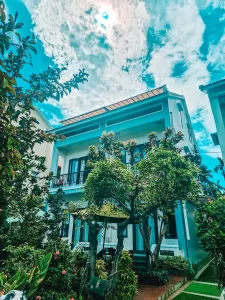
There’s an abundance of choice for hotels in Hoi An, from charming local stays to riverside resorts. While there are hotels in the Ancient Town itself, I’d personally be cautious about choosing these, as Hoi An is a town that really comes alive at night and you’re likely to experience street noise.
You can also choose to stay on one of the two islands opposite the main town. An Hoi is where the main night market happens, and the front street is lined with bars – I would avoid these areas. Beyond this, the back streets of the island are quieter.
I stayed on Cam Nam, where there are far fewer tourists. This quiet island is about 10 minutes walk from the Ancient Town, but feels a million peaceful miles away. While there are a number of hotels, there are still lots of private houses, and it feels much less touristy.
If you can afford it, there are also a lot of beautiful upmarket hotels lining the river. These have stunning views and are usually away from the noise of the main town.
Options include:
Yen Villas – this is where I stayed, and I can’t recommend it highly enough. Rooms are spacious and clean. The aircon works, and there is a beautiful small pool. The family running the small hotel are among the most helpful and kind people I’ve come across while travelling. It’s around $15 per night.
Hoi An Town Centre Hotel – on An Hoi, this highly rated hotel is budget/mid-range for Vietnam (around $20 a night). It has excellent reviews, and is away from the noise of the night market.
River Town Hoi An Resort and Spa – also on An Hoi, but on the riverfront, this 5* resort has over 2000 reviews, a 4.7 rating on google and costs around $75 per night.
Mulberry Collection Silk Eco – if you’re keen to stay on the mainland, this 4* hotel has over 700 reviews on google and a 4.5 rating.
Where should I stay in Hue?
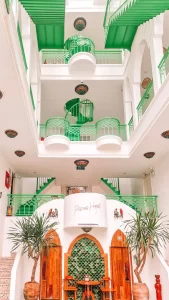
The best area to stay in Hue is around the central tourist streets, although I would avoid staying directly on busy streets such as Walking Street due to the noise from local bars. Several hotels are down quiet, safe backstreets and these are a great combination of proximity to the centre combined with peace.
Pisces Hotel – this incredible hotel is where I stayed. The design is just amazing, making it one of the most Instagrammable hotels I’ve ever stayed in. While I sadly found that the water pressure wasn’t quite strong enough for the enormous bathtub in my room, I would still recommend this hotel for its central location and spacious rooms. Instagrammable without feeling overhyped—Pisces is the kind of place you’ll want to come back to.
Than Thien Friendly Hotel – this is where I’d booked to stay before I found the Pisces Hotel. It’s a highly rated, budget hotel in a central location. I did however note that it’s on a street with a lot of traffic, so if you’re a light sleeper consider asking for a room at the back.
Are there vegetarian or vegan options in Central Vietnam?

Yes! Vietnamese cuisine has excellent plant-based dishes, and you can find dedicated vegetarian and vegan restaurants in Hue, Hoi An and Da Nang. Popular dishes include bánh xèo (local pancakes) with mushrooms, veggie pho, vegetable spring rolls and vegan versions of cao lầu.

I hope this 10-day Central Vietnam Itinerary helps you feel confident, excited, and—most importantly—ready to book your trip. Planning travel in a region with so much to offer can be overwhelming, but with the right flow, you’ll get to experience the magic of Hoi An’s ancient streets, Da Nang’s laid-back coast, and Hue’s regal history without the stress. Together, these cities offer a perfect balance of culture, relaxation, and adventure.
From sipping coffee in heritage cafés to riding the Hai Van Pass with an Easyrider guide, this itinerary is crafted from real experience—not just guesswork from Google Maps. You deserve a journey that’s as fulfilling as it is fun, and Central Vietnam delivers that in spades. Safe travels—and if you have any questions or want tips tailored to your travel style, feel free to drop a comment or reach out. I’d love to help you plan something unforgettable.


